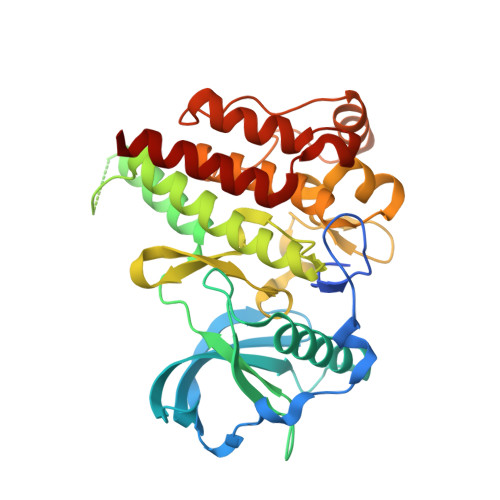Synthesis and Development of Highly Selective Pyrrolo[2,3- d ]pyrimidine CSF1R Inhibitors Targeting the Autoinhibited Form.
Aarhus, T.I., Bjornstad, F., Wolowczyk, C., Larsen, K.U., Rognstad, L., Leithaug, T., Unger, A., Habenberger, P., Wolf, A., Bjorkoy, G., Pridans, C., Eickhoff, J., Klebl, B., Hoff, B.H., Sundby, E.(2023) J Med Chem 66: 6959-6980
- PubMed: 37191268
- DOI: https://doi.org/10.1021/acs.jmedchem.3c00428
- Primary Citation of Related Structures:
8CGC - PubMed Abstract:
Colony-stimulating factor-1 receptor (CSF1R) is a receptor tyrosine kinase that controls the differentiation and maintenance of most tissue-resident macrophages, and the inhibition of CSF1R has been suggested as a possible therapy for a range of human disorders. Herein, we present the synthesis, development, and structure-activity relationship of a series of highly selective pyrrolo[2,3- d ]pyrimidines, showing subnanomolar enzymatic inhibition of this receptor and with excellent selectivity toward other kinases in the platelet-derived growth factor receptor (PDGFR) family. The crystal structure of the protein and 23 revealed that the binding conformation of the protein is DFG-out-like. The most promising compounds in this series were profiled for cellular potency and subjected to pharmacokinetic profiling and in vivo stability, indicating that this compound class could be relevant in a potential disease setting. Additionally, these compounds inhibited primarily the autoinhibited form of the receptor, contrasting the behavior of pexidartinib, which could explain the exquisite selectivity of these structures.
- Department of Materials Science & Engineering, Norwegian University of Science and Technology (NTNU), NO-7491 Trondheim, Norway.
Organizational Affiliation:



















